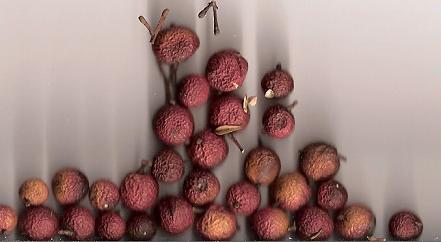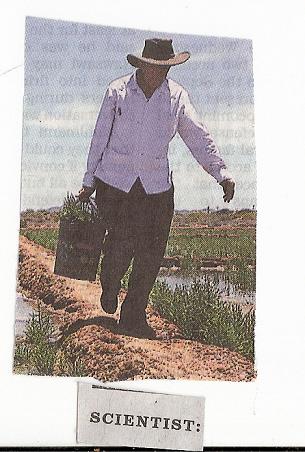THE SEEDS OF BIOFUEL SALVATION: In my backyard
A rich variety of schemes have been furnished as potential cures for the energy crisis. Most of them speak to flaws peculiar to the American psyche: a wish for easy answers, the desire to always have something for nothing, and the blanket refusal to entertain the idea that we use too much energy and that, sooner or later, we're going to have to make do with much much less. (The banner example is southern California, DD's home for the last fifteen years. Had a majority of the middle and upper-middle class not thought driving two hours to work each day in gridlocked traffic just so they could have a big house was swell and sustainable, they would not now be having strokes over many $100 fill-ups at the gas station.)
The best laff-riots in the current crop of energy-independence suggestions come from the biofuel sector, an industry prone to desperate exaggerations.
A couple of weeks back DD went into this at The Register, profiling how a number of trash plants -- kudzu and jatropha -- generate a regular stream of stories on how they'll furnish the oil fields of the future. (See here.
The US newsmedia is an easy conduit for these types of salvation-is-coming-if-only-the-disbelievers-would-get-out-of-the-way pieces. Most of the time, readers don't know how they are developed. However, since DD worked at a newspaper for a number of years, he can tell you.
Simply, everyone with pet obsessions and business plans comes crawling out of the woodwork with press releases and phone calls when their hobbyhorses fit the current national crisis, need or fad.
Now, not everyone peddling salvation is a shill. Some of the people are sincere and possessed by something they've been working at, perhaps with only marginal success, for decades. Many others, however, are rascals.
In today's Los Angeles Times, the latest trash plant given the treatment is salicornia, a weed that grows on salt water.
"Scientist Carl Hodges thinks big: Why not harness rising oceans to grow a desert food crop that could also one day overtake oil as a fuel?" asks the newspaper's subhed.
Naturally, the world is promised -- biofuel, harnessing of the rising ocean part of global warming, carbon dioxide sequestration and food.
Much of this is built on the standard irresistible hook of the plant which offers everything for nothing. For example, in the late Eighties and early Nineties in the Lehigh Valley, a company known as Rodale had researchers who were always pitching amaranth, a bitter-tasting weed which grows on virtually nothing, as the new wheat.
In today's case it's salicornia. Two weeks ago on the biofuel beat it was kudzu, jatropha and algae, the latter which also crops up in today's Times piece.
The problem with the prescription is that the plants do deliver something, but never nearly as much as billed. And the scale of return on investment isn't in any way up to the bank of energy millions of years has built into petroleum.
This is hinted at in the story in only two places: (1) statements that diverting the equivalent of three Mississippi Rivers inland and covering the entire Sahara with the plant would do the trick, and (2) salicornia is said to be able to produce 148 gallons of biofuel per acre per year as opposed to soy beans, which only produce 48.
The alert reader will notice salicornia, if you believe the figure, is not an order of magnitude improvement on soy beans, which aren't such hot sources of fuel. Indeed, the production of biodiesel in the US is so small as to be considered almost nonexistent in the pool of liquid fuel requirement. And a difference of a factor of three between salicornia and soy is not a game changer.
Indeed, the limiting factor in all biofuel-as-replacers-of-oil schemes involve differences in orders of magnitude, with renewables always on the bottom side of the energy equation.
Hodges has been working on his dream for close to four decades. There can be no doubt he is a sincere man who will pursue the dream until he can no longer do so. However, over the intervening years, the investments in salicornia as a potential world-beater appear to have been trivial. There's no evidence furnished in the story that it can be anything but a tiny bit player, if that.
However, the plans look good. And they are furnished with pictures which serve to underline the various claims put forward in the story.

DD put the red virtual pencil to this to underscore the message. You can eat salicornia. You can burn it. You can squeeze the stuff for oil and make biodiesel!

Dick Destiny's sesame seeds. You can eat sesame seeds! You can burn them! You can make biodiesel from sesame oil!

Indeterminate oily seeds from a bushy weed in DD's backyard. You can burn them! Sometimes, animals appear to eat them! They sequester carbon. Ad nauseam.

Letting the Sea Cultivate the Land -- The LA Times story on miraculous salicornia.
A rich variety of schemes have been furnished as potential cures for the energy crisis. Most of them speak to flaws peculiar to the American psyche: a wish for easy answers, the desire to always have something for nothing, and the blanket refusal to entertain the idea that we use too much energy and that, sooner or later, we're going to have to make do with much much less. (The banner example is southern California, DD's home for the last fifteen years. Had a majority of the middle and upper-middle class not thought driving two hours to work each day in gridlocked traffic just so they could have a big house was swell and sustainable, they would not now be having strokes over many $100 fill-ups at the gas station.)
The best laff-riots in the current crop of energy-independence suggestions come from the biofuel sector, an industry prone to desperate exaggerations.
A couple of weeks back DD went into this at The Register, profiling how a number of trash plants -- kudzu and jatropha -- generate a regular stream of stories on how they'll furnish the oil fields of the future. (See here.
The US newsmedia is an easy conduit for these types of salvation-is-coming-if-only-the-disbelievers-would-get-out-of-the-way pieces. Most of the time, readers don't know how they are developed. However, since DD worked at a newspaper for a number of years, he can tell you.
Simply, everyone with pet obsessions and business plans comes crawling out of the woodwork with press releases and phone calls when their hobbyhorses fit the current national crisis, need or fad.
Now, not everyone peddling salvation is a shill. Some of the people are sincere and possessed by something they've been working at, perhaps with only marginal success, for decades. Many others, however, are rascals.
In today's Los Angeles Times, the latest trash plant given the treatment is salicornia, a weed that grows on salt water.
"Scientist Carl Hodges thinks big: Why not harness rising oceans to grow a desert food crop that could also one day overtake oil as a fuel?" asks the newspaper's subhed.
Naturally, the world is promised -- biofuel, harnessing of the rising ocean part of global warming, carbon dioxide sequestration and food.
Much of this is built on the standard irresistible hook of the plant which offers everything for nothing. For example, in the late Eighties and early Nineties in the Lehigh Valley, a company known as Rodale had researchers who were always pitching amaranth, a bitter-tasting weed which grows on virtually nothing, as the new wheat.
In today's case it's salicornia. Two weeks ago on the biofuel beat it was kudzu, jatropha and algae, the latter which also crops up in today's Times piece.
The problem with the prescription is that the plants do deliver something, but never nearly as much as billed. And the scale of return on investment isn't in any way up to the bank of energy millions of years has built into petroleum.
This is hinted at in the story in only two places: (1) statements that diverting the equivalent of three Mississippi Rivers inland and covering the entire Sahara with the plant would do the trick, and (2) salicornia is said to be able to produce 148 gallons of biofuel per acre per year as opposed to soy beans, which only produce 48.
The alert reader will notice salicornia, if you believe the figure, is not an order of magnitude improvement on soy beans, which aren't such hot sources of fuel. Indeed, the production of biodiesel in the US is so small as to be considered almost nonexistent in the pool of liquid fuel requirement. And a difference of a factor of three between salicornia and soy is not a game changer.
Indeed, the limiting factor in all biofuel-as-replacers-of-oil schemes involve differences in orders of magnitude, with renewables always on the bottom side of the energy equation.
Hodges has been working on his dream for close to four decades. There can be no doubt he is a sincere man who will pursue the dream until he can no longer do so. However, over the intervening years, the investments in salicornia as a potential world-beater appear to have been trivial. There's no evidence furnished in the story that it can be anything but a tiny bit player, if that.
However, the plans look good. And they are furnished with pictures which serve to underline the various claims put forward in the story.
DD put the red virtual pencil to this to underscore the message. You can eat salicornia. You can burn it. You can squeeze the stuff for oil and make biodiesel!
Dick Destiny's sesame seeds. You can eat sesame seeds! You can burn them! You can make biodiesel from sesame oil!
Indeterminate oily seeds from a bushy weed in DD's backyard. You can burn them! Sometimes, animals appear to eat them! They sequester carbon. Ad nauseam.

Letting the Sea Cultivate the Land -- The LA Times story on miraculous salicornia.

2 Comments:
By my calculations, we need about 300,000,000 acres of land to make enough bio-fuel to supply our needs. That leaves about 140,000,000 acres for cropland. I'm not an economist, but I believe it means a lot more hungry people in-country. And that's just for diesel fuel.
In college, I had the pleasure of reading "The Forgotten Fundamentals of the Energy Crisis" by Dr. Albert A. Bartlett. He succinctly addresses America's penchant for belief transcending over physical reality by stating Disney's First Law: "Wishing will make it so."
I still consider it the most profound paper I've ever read with respect to our energy policy. The paper is a great refresher course on the core narcissistic American belief that we're entitled to maintain and expand our energy consumption--no matter what.
Has any organisation done research on kudzu? Is any investment happening in This field? what is the Level of commercialisation? Is there a report i can get on kudzu? When did the research in to this field start? Is India a leader in this kudzu opportunity? or is it atleast prevalent in India?
Can anybody answer these queries?
sanjay.arunkumar@yahoo.in
Post a Comment
<< Home